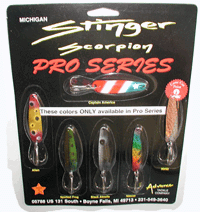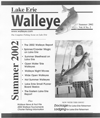By Mark Romanack
I had just completed setting out a 4th Off Shore Tackle Side Planer when
my youngest son Jake looked at me with a puzzled face and asked, "Dad how do
we tell when we have a fish?"
 An
elementary but important question, reading or detecting strikes when using
in-line boards isn't an easy concept to explain or grasp.
An
elementary but important question, reading or detecting strikes when using
in-line boards isn't an easy concept to explain or grasp.
I thought for a moment and then answered, "When a fish
grabs our lure, the board will jerk backwards in the water." The look on
Jakeís face suggested he wasn't sure exactly what to expect next. I went on
to explain that the weight of the fish pulling and fighting against the
board causes it to jerk or pull backwards in the water. By watching and
comparing to the other boards, it's pretty easy to tell if a board has
hooked a fish.
The truth is it's pretty easy to tell when a fish is hooked on the Side
Planer board. Pretty easy so long as the fish is good sized, youíre trolling
straight downwind, the boat doesn't turn and you happen to see the strike
the moment it occurs!
Unfortunately there are times when even a seasoned troller can drag fish
he didn't know was hooked. Small fish are tougher to detect because they
arenít big enough to cause the board to react violently or in an .obvious
way. Quartering into the waves (instead of trolling straight with or into
the wind) also makes it more difficult to read in-line boards. When a
fishing boat quarters the waves it doesn't enjoy a steady and smooth course.
The wind turns the boat, forcing the driver to constantly adjust his course.
The boat moves forward but is actually swinging back and forth along an
imaginary centerline. The trailing' boards follow the boat, swinging back
and forth instead of following a steady and straight course.
Each time the boat turns toward one of the boards the line goes a little
slack and the board sags backward slightly, then recovers when the boat
turns again and the line pulls tight.
If a fish is hooked while the boat is in a subtle turn there's just
enough slack in the line to prevent the board from showing obvious movement.
The weight of the hooked fish does cause the board to sag backward, but it's
easy to miss even if you're an experienced troller. Eventually the boat will
pull straight or turn the opposite direction. When this happens the board
with a fish attached always seems to be lagging a little behind the others.
The rule of thumb is to always check lines that are sagging a little or
don't look just right. It only takes a minute or two to check the line and
be sure you're not dragging a small fish or a fouled lure.
Turns are the toughest place to detect strikes on inline boards. During a
turn the outside lines speed up while at the same time the inside lines
stall and slow down. Of course the trailing lures do the same thing, helping
to trigger strikes.
If a fish is hooked on an outside line, it is usually pretty easy to
detect because the board is moving in a steady path. It's the inside boards
that are stalling that are tougher to read. Often a fish hooked on the
inside lines isn't apparent until the boat straightens out again. A fish
hooked on the inside lines often prevents the board from pulling back out to
the side properly once the boat straightens out. Again, a board that always
seems to be lagging behind is a tip off that something is wrong.
How Far Do I Run My Boards Out to the Side?
It's also easier to detect strikes when the boards are fished within 50 -
75 feet of the boat. When the boards are let out 100 or more feet away from
the boat, slight changes in course cause the boards to momentarily stall and
start, making it more difficult to tell if a fish has been hooked. This is
especially true if the target fish are small.
Running the boards a little closer to the boat makes subtle changes in
how the board is running more obvious. However, there's obviously a point of
diminishing return. Fishing the boards too close to the boat defeats the
purpose of using boards in the first place. Running the boards 50- 75 feet
out is a good rule of thumb when you're first learning how to read planer
boards. Once you get a little experience, Iíd recommend running the boards
out 75-100 feet. Many of the top walleye pros run their boards as far as 150
out to the side.
TROLL WITH THE WIND
Trolling with the wind makes it easier to read the boards, no matter how
far out to the side they are fished. In a following sea the boardsí run
smoothly and in a predictable manner. When trolling into the waves, the
boards jump around, leap out of the waves and otherwise hop all over the
place. While this board action can trigger strikes, reading these strikes is
tricky for even those anglers who have considerable experience fishing
in-line boards.
LOW STRETCH LINES HELP
Using low stretch lines such as the super braids or fused lines makes it
very easy to detect hooked fish on in-line boards. Because the line doesn't
stretch, anything that touches the lure causes the board to react
accordingly. When fishing low stretch lines I recommend using the new Off
Shore Tackle OR-18 Snapper Release that's designed to hold this thin and
slippery surfaced line securely. Snapper releases are sold individually and
can be installed on most in-line boards.
MATCHING UP LURES
Certain lures pull harder in the water than others.
Matching up lures that generate similar drag or pulling resistance allows
the board to run in a more uniform manner that's easier to monitor. Avoid
running a deep diving lure with lots of drag next to a shallow diving lure
with little drag.
TATTLE FLAGS
No matter how good you get at reading in-line boards,
there will be times when a small fish or fouled lure is dragged around. The
ultimate solution to this problem is the OR-12TF Tattle Flag produced by Off
Shore Tackle.
The Tattle Flag is a spring loaded flag kit that allows
the flag to fold down when a fish is hooked. The Tattle Flag is so sensitive
even a crank bait thatís fouled with a piece of weed causes the flag to fold
to half mast. 1'iever again will you drag a small fish or fouled lures with
the Tattle Flag.
Designed as an after market kit, a Tattle Flag can be
installed on an OR-12 Side-Planer board in about five minutes. The kit comes
complete with a flag, spring/linkage assembly, two OR-16 Snap Weight
clips and the necessary hardware.
Reading the boards is part science and part intuition. If
for any reason you suspect something is wrong with the way a board is
running, take a few seconds and check that line. The bait could have become
fouled on something floating in the water, picked up a weed or a cluster of
zebra mussels. It's better to check immediately than to drag something
around, twisting the line in the process.





 An
elementary but important question, reading or detecting strikes when using
in-line boards isn't an easy concept to explain or grasp.
An
elementary but important question, reading or detecting strikes when using
in-line boards isn't an easy concept to explain or grasp.